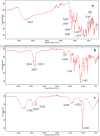Molecular insights into the aggregation and solubilizing behavior of biocompatible amphiphiles Gelucire® 48/16 and Tetronics® 1304 in aqueous media
- PMID: 37780735
- PMCID: PMC10540152
- DOI: 10.1039/d3ra04844f
Molecular insights into the aggregation and solubilizing behavior of biocompatible amphiphiles Gelucire® 48/16 and Tetronics® 1304 in aqueous media
Abstract
A comparative analysis of the micellar and solubilizing properties of two polyethylene glycol (PEG)-based amphiphilic biocompatible excipients: Gelucire® 48/16 (Ge 48/16) and Tetronics® 1304 (T1304), in the presence and absence of salt, was conducted. As there is a dearth of research in this area, the study aims to shed light on the behavior of these two nonionic surfactants and their potential as nanocarriers for solubilizing pharmaceuticals. Various techniques such as cloud point (CP), dynamic light scattering (DLS), small-angle neutron scattering (SANS), Fourier transform infrared spectroscopy (FT-IR), UV spectrophotometry, and high-performance liquid chromatography (HPLC) were employed. The solubility of quercetin (QCT), a flavonoid with anti-inflammatory, antioxidant, and anti-cancer properties, was evaluated and the interaction between QCT and the micellar system was examined. The analysis revealed the occurrence of strong interactions between QCT and surfactant molecules, resulting in enhanced solubility. It was observed that the micellar size and solubilizing ability were significantly improved in the presence of salt, while the CP decreased. Ge 48/16 exhibited superior performance, with a remarkable increase in the solubility of QCT in the presence of salt, suggesting its potential as an effective nanocarrier for a range of pharmaceutics, and yielding better therapeutic outcomes.
This journal is © The Royal Society of Chemistry.
Conflict of interest statement
There are no conflicts to declare.
Figures







Similar articles
-
A multitechnique approach on adsorption, self-assembly and quercetin solubilization by Tetronics® micelles in aqueous solutions modulated by glycine.Colloids Surf B Biointerfaces. 2016 Dec 1;148:411-421. doi: 10.1016/j.colsurfb.2016.09.014. Epub 2016 Sep 12. Colloids Surf B Biointerfaces. 2016. PMID: 27639491
-
Micellar assembly leading to structural growth/transition in normal and reverse Tetronics® in single and mixed solution environment.Soft Matter. 2022 Jun 22;18(24):4543-4553. doi: 10.1039/d2sm00321j. Soft Matter. 2022. PMID: 35674288
-
Additive-anchored thermoresponsive nanoscale self-assembly generation in normal and reverse Tetronics®.Phys Chem Chem Phys. 2024 Feb 14;26(7):6372-6385. doi: 10.1039/d3cp06329a. Phys Chem Chem Phys. 2024. PMID: 38315058
-
Concentration, temperature, and salt-induced micellization of a triblock copolymer Pluronic L64 in aqueous media.J Colloid Interface Sci. 2005 Dec 15;292(2):548-56. doi: 10.1016/j.jcis.2005.06.013. Epub 2005 Jul 15. J Colloid Interface Sci. 2005. PMID: 16024036
-
Influence of a hydrophobic diol on the micellar transitions of Pluronic P85 in aqueous solution.J Colloid Interface Sci. 2008 Apr 15;320(2):452-9. doi: 10.1016/j.jcis.2008.01.050. Epub 2008 Feb 2. J Colloid Interface Sci. 2008. PMID: 18275966
Cited by
-
Cadmium telluride quantum dot-MXene composite-based electrochemical sensing platform for simultaneous determination of rutin and quercetin in foods.Mikrochim Acta. 2025 Mar 18;192(4):238. doi: 10.1007/s00604-025-07092-2. Mikrochim Acta. 2025. PMID: 40100447
References
-
- Rangel-Yagui C. O. Pessoa Jr A. Tavares L. C. J. Pharm. Pharm. Sci. 2005;8:147–163. - PubMed
-
- Torchilin V. P. J. Pharm. Res. 2007;24:1–16. - PubMed
-
- Lipinski C. A. J. Pharmacol. Toxicol. Methods. 2000;44:235–249. - PubMed
-
- Merisko-Liversidge E. M. Liversidge G. G. Toxicol. Pathol. 2008;36:43–48. - PubMed
-
- Kawabata Y. Wada K. Nakatani M. Yamada S. Onoue S. Int. J. Pharm. 2011;420:1–10. - PubMed
LinkOut - more resources
Full Text Sources
Research Materials
Miscellaneous

